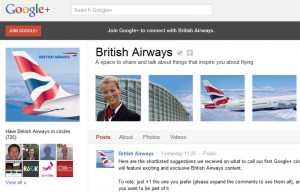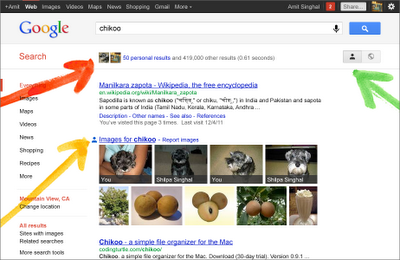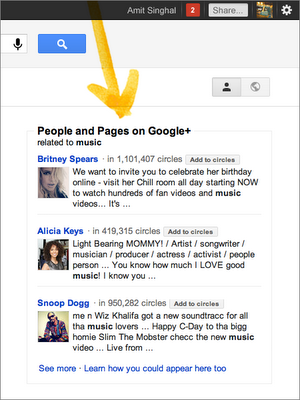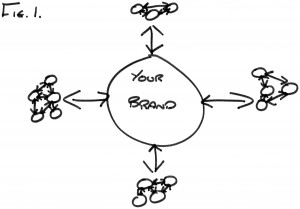How Seriously Should Travel Marketers Take Google+?
Since Google launched its social sharing service Google+ 7 months ago, it’s remained at the bottom of the priority list for travel and tourism marketers – a poor third behind Facebook and Twitter. Even when Google launched brand pages to emulate those on Facebook, there was hardly a stampede of travel and tourism brands to set them up. But all of that has changed.
That’s because Google has announced the release of ‘Search Plus Your World’ – the integration of ‘public’ search results and private search results from the user’s social network. And the user’s network is defined solely as their connections on Google+.
So now, if you’re a Google+ member and you search whilst logged into Google, you’ll see not only the usual results you’d expect to see from the public web but also content you’ve shared on Google+ and content your connections have made public or shared with you (see below).
Not only that but Google will also recommend ‘People & Pages’ results in a box on the right hand side of the main results page for certain searches – basically people and companies on Google+ that Google believes are authorities on the subjects you’ve search for (although the eg Google provides is a search for ‘music’ which returns Britney Spears as a recommended profile – debateable…). This is a way of encouraging users to build out their Google+ connections but, as these results will also sometimes be delivered to those who aren’t logged into Google, it’s a chance to attract more subscribers too.
Now search has been a personal experience for some time. For example, my results are tailored based on my location and, if I’m signed into Google, the sites I’ve shown a preference for visiting. But if Google+ and ‘Search Plus Your World’ takes off then the whole concept of chasing positions on the SERPs (search engine results pages) becomes meaningless as there won’t be a standard SERP for any query.
Travel companies have been rather slow to jump onto the social media bandwagon – you just need to look at the fact that British Airways has just 196,000 fans on Facebook compared to the following of another iconic British brand, Burberry, at 10m+. But this change is certainly going to make travel marketers sit up and take notice because it inextricably links social media with something we all know is a proven business driver – search.
 By creating a Google+ page – and British Airways already has – building a following and creating and sharing content optimised for search, a travel brand increases the chances that the content created, and its Google+ profile, will appear in the personalised search results of their Google+ connections and the friends of those connections. And by focusing that content on a specific authority topic, they also increase the chance their profile will appear on searches related to that topic in the ‘People and Pages’ box.
By creating a Google+ page – and British Airways already has – building a following and creating and sharing content optimised for search, a travel brand increases the chances that the content created, and its Google+ profile, will appear in the personalised search results of their Google+ connections and the friends of those connections. And by focusing that content on a specific authority topic, they also increase the chance their profile will appear on searches related to that topic in the ‘People and Pages’ box.
Hence, social media is directly driving search results, and we know search engine results lead to traffic and bookings. Suddenly, social media has business case.
Or does it? There are 4 drawbacks to note before rushing headlong to turn your social media strategy upside down.
Firstly, although Google+ is growing fast (90m subscribers announced by Larry Page last week) we don’t know where they are, who they are or, more tellingly, how much and what they’re sharing. Reports I’ve read suggest that the average Google+ subscriber is biased male and techy. How much sharing of holiday content is actually going on?
Secondly, marketers need to be where their target market is and their target market is more likely to be on Facebook and, to a lesser extent, on Twitter. Not only are their numbers bigger – much bigger in Facebook’s case – but we don’t understand how Google+ subscribers are using the service. Has it become their primary social profile or just a ‘handy to have’ extra on top of Facebook which they’ve subscribed to because they’ve subscribed to other Google services such as Gmail? And how compelling will social search prove to users – so compelling that they stampede to sign up to Google+?
Thirdly, how effective will social search be? Will it really drive traffic. We all know that recommendations from friends and family play a large part in the holiday decison process but will this translate to recommendations delivered ‘impersonally’ via search results?
And finally, I’m not sure this is the last move in what could be a long game. I can imagine antitrust legislators looking carefully at Google’s move to promote just it’s own social service within search results. Google must know this so maybe this is just part of a process designed to force the hands of their rivals and get access to more social data from Facebook and Twitter to enhance their search results and spike any attempts for Bing/Facebook to enhance their own search offerings.
That said, I’m recommending to my clients that they set up a Google+ page sooner rather than later. The unknowns can tip both ways and I’d rather be playing the game and watching the impact on my business from the inside rather than wondered what’s happening from the outside.
So I’d recommend you set up your Google+ page, integrate buttons across your other channels (website, email etc) to build a following (although don’t raise your expectations too high – think Twitter following rather than Facebook following in terms of numbers) and start posting. To save time, you may want to post the content you’re sharing on Facebook anyway, although to make the most of the channel you’d be better advised to modify your posts to include your key search terms.
Then just wait and see. Watch referral traffic or changes in traffic from various search terms your posts are optimised around and let that be the guide to how much time you dedicate to managing your profile.






